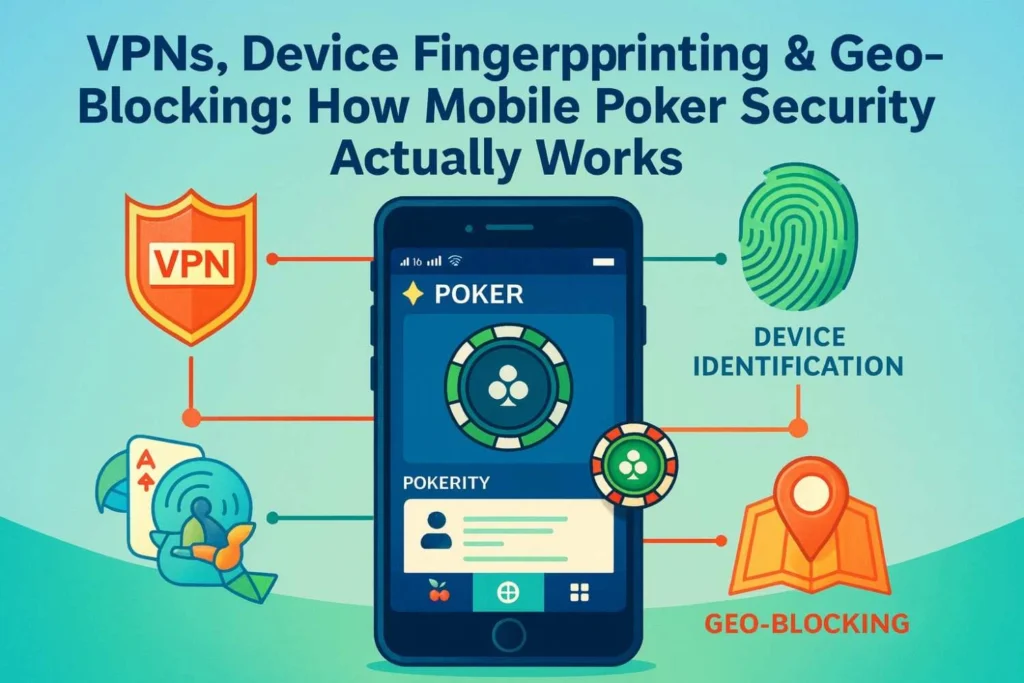
If you’ve ever grabbed your phone, opened a mobile poker online app, and wondered how it manages to keep millions of global players safe every single day, you’re not alone. At the center of all these safeguards lies Mobile Poker Security, a system that has evolved dramatically in the last few years. With real-money games booming, VPN trickery rising, identity spoofing spreading, and regulations tightening, poker platforms now rely on a mix of cutting-edge cybersecurity tools that seem straight out of a spy thriller. Whether it’s VPN tracing, device fingerprinting, or geo-blocking, these invisible layers work together to answer the player’s most important question: Is online poker safe?
How Mobile Poker Security Adapts to Modern Threats
Mobile Poker Security & the Move Toward “Invisible Protection”
The modern poker experience is designed so security operates quietly in the background rather than interrupting gameplay with constant verification requests. Instead of forcing players to jump through hoops, today’s systems silently analyze interactions and build real-time threat profiles. This approach ensures that honest players enjoy a smooth game, while suspicious activity is flagged instantly without disturbing the action.
Silent Security Features Used Today:
- Behavioral biometrics track natural habits, such as tap pressure, swipe speed, and typing rhythm, to verify the user’s identity even when traditional credentials remain unchanged.
- Device profiling examines each player’s hardware and operating system, enabling poker apps to detect tampered devices or unusual changes that may signal fraud.
- Geolocation triangulation cross-checks GPS, WiFi, and cell tower data to ensure a player is actually located where their connection claims they are.
- AI-driven fraud scoring monitors gameplay patterns in real time, catching inconsistencies before they escalate into major risks.
Mobile Poker Security & Real-Time Risk Engines That Think Faster Than Cheaters
Risk engines are the beating heart of modern poker protection. They continuously examine gameplay patterns, and when something feels “off,” they react instantly. These engines don’t just check surface-level behavior, they examine deeper analytics that reveal whether a player’s actions align with natural human tendencies.
What These Engines Monitor:
- They evaluate betting rhythms to spot players who act with machine-like precision, which often indicates bot involvement or automated scripts.
- They watch the speed of decision-making to identify unnatural delays or overly rapid choices, which often differ from normal human reactions.
- They detect potential collusion by analyzing repeated coordinated actions between two or more players across multiple games.
- They flag chip-dumping attempts by tracking suspicious transfers in which one player intentionally loses large amounts of chips to another.
To deepen your understanding of high-equity decision making and nut-heavy strategies, check out the advanced insights shared at Bluffing Monkeys. It’s a solid resource for breaking down hand selection and game planning, especially as complexity increases in Big O formats.
The Three Technologies Behind Real Mobile Poker Protection
VPN Detection: The First Wall Every Poker Player Must Pass Through
VPN usage is extremely common among players trying to bypass region restrictions or access higher-stakes tables. However, modern poker apps have developed sophisticated methods to expose masked connections even when high-end VPNs are used. Poker systems cross-analyze network behavior and connection stability to determine whether a user’s location is authentic.
How Poker Apps Actually Identify VPN Users:
- They match IP addresses against enormous databases of known VPN servers, ensuring that even newly added servers are detected quickly.
- They analyze latency fluctuations because VPN connections often show inconsistent ping patterns that differ from regular network routing.
- They test for DNS leaks, which occur when a VPN hides the IP but fails to mask underlying DNS requests.
- They compare current device behavior to past login patterns, making sudden location shifts appear suspicious even if the VPN itself is well disguised.
VPN detection matters because poker platforms must follow local gaming regulations, ensure correct taxation, prevent underage gambling, and stop fraud rings that rely on location spoofing. For legitimate players looking to explore safe, verified platforms, checking options on the Club List can help ensure you’re playing within the rules.
Device Fingerprinting: Building a “Digital Identity” That Players Cannot Fake
Device fingerprinting is one of the strongest forms of authentication today because it creates a unique profile that remains recognizable even if players change their IP, browser, or network. This fingerprint works like a digital DNA signature that is nearly impossible to erase.
How Fingerprinting Works:
- The system records hardware identifiers such as CPU type, GPU model, and screen resolution, which vary subtly from device to device.
- It checks installed fonts, storage characteristics, and OS version, creating a combination of data points incredibly hard to replicate.
- It observes motion sensors, like gyroscope and accelerometer behavior, which differ slightly between devices and add another layer of uniqueness.
- It tracks long-term usage patterns so that even if someone uses a fresh poker download or resets their phone, the underlying behavior still reveals their identity.
This prevents multi-accounting, chip dumping, bonus abuse, and coordinated bot activity by ensuring that one physical device cannot disguise itself as multiple players.
Geo-Blocking & Location Triangulation: More Than Just an IP Check
Geo-blocking has evolved far beyond checking where an IP address originates. Modern poker platforms now verify a player’s physical location using multiple independent data sources. This prevents players from entering regions where poker is restricted and ensures that matches stay fair and regulation-compliant.
How Geo-Verification Works Today:
- GPS signals are compared with WiFi-based location data to ensure both match, reducing the chances of GPS spoofing tools working effectively.
- Cell tower triangulation checks nearby towers to confirm that the device’s signal is physically located where the GPS claims it is.
- Router MAC analysis identifies local network signatures, making it nearly impossible for users to fake their connection’s true origin.
- Bluetooth proximity scanning checks for nearby active devices, providing additional confirmation that the user is in a legitimate physical space.
These tools are especially critical in high-stakes environments where ICM (Independent Chip Model) concepts heavily influence late-stage tournament decisions. Fair geographic verification protects prize pools and ensures that ICM-driven decisions—such as deal-making, chip equity, or risk-adjusted fold equity—are made without interference from hidden or restricted accounts.
Security Layers Borrowed From Banking & Fintech
Poker apps now use many of the same security technologies as leading financial institutions. They encrypt all sensitive data so that even if communication is intercepted, it becomes useless to attackers. Payment systems rely on tokenized transactions, meaning card details are never exposed directly. Fraud heat maps highlight unusual spending patterns, making it easier to stop financial fraud in real time. These improvements bring poker security closer to banking-level safety than ever before.
Emerging Trends in 2025 That Are Redefining Poker Security
Web3 Transparency for Fair-Play Verification
Some modern poker platforms use blockchain to record random number generator (RNG) seeds and shuffle verifications, allowing players to check that each hand was generated fairly and without manipulation.
Behavioral AI That Detects Cheating Within Seconds
Next-generation AI systems analyze micro-behaviors, such as reaction times, betting correlation between players, and unusual decision combinations, to detect cheating in real time before it affects gameplay.
Smarter Fraud Detection for Deposits & Withdrawals
Payment verification systems now compare device history, wallet patterns, transaction frequency, and location stability to ensure each withdrawal request comes from a legitimate user rather than a hijacked account.
Extra Security Layers Players Rarely Notice
Certain measures are intentionally invisible. Anti-bot captchas are sometimes hidden within routine game actions, where they appear as subtle interaction checks that only humans can perform naturally. Anti-tamper code embedded in the app prevents modifications, so even if someone tries to inject cheats, the system shuts down or isolates the session. Server-side validation ensures that all card dealing happens on a secure server rather than on the user’s device, making it impossible for attackers to manipulate hands.
These layers are critical for maintaining a trusted poker environment, especially for players who’ve learned about poker integrity the hard way where even small vulnerabilities can lead to unfair advantages. In this evolving digital space, real protection happens behind the scenes, long before a single hand is dealt.
For Developers: What the Top Poker Apps Are Doing Differently
Leading apps now combine strong encryption, region-based compliance, and real-time cheating analytics with modern technologies like Node.js, Go, Redis, Firebase, and Unity. These choices deliver smoother gameplay, faster matchmaking, and secure multi-region support. Developers also focus on UX by adding fair-play certifications, advanced KYC verification, loyalty programs, and player reputation scoring to keep the ecosystem safer and more competitive.
Conclusion
Mobile poker security has evolved into a sophisticated blend of VPN detection, device fingerprinting, geo-blocking, encryption, and AI-powered risk analysis. These systems work together behind the scenes to protect players, uphold fairness, and maintain regulatory compliance across global markets. Whether you’re a developer building a new poker app or a player simply exploring whether online poker is safe, the modern security landscape ensures you’re better protected than ever before. With these powerful safeguards in place, mobile poker is entering its most secure and trustworthy era yet.
FAQs
Q. Is online poker safe?
Yes. Modern poker platforms now use banking-level encryption, AI-driven fraud detection, location verification, and device fingerprinting to secure player data and ensure fair gameplay across every table.
Q. Can VPNs bypass poker region restrictions?
They may work temporarily, but advanced detection systems track suspicious IP changes, GPS mismatches, and behavioral inconsistencies, making it extremely difficult for VPN users to stay undetected.
Q. Why do poker apps require access to my location?
They need accurate location verification to comply with regional gambling laws and to prevent cheating methods involving GPS spoofing or unauthorized cross-border play.
Q. Is mobile poker online safer than desktop poker?
Yes, because mobile devices offer stronger hardware-level protection, built-in encryption, and limited susceptibility to traditional malware and browser-based exploits.
